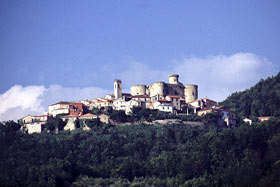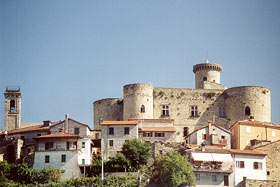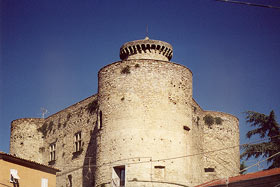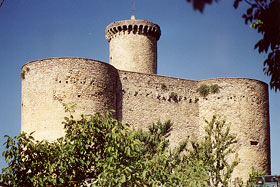The castle rises at the center of the little medieval
suburb of Bastia, crowning a hill of 500 meters high, above the town
of Licciana Nardi, in the valley of the Taverone river (high Lunigiana).
It is located in a strategical position in the valley that in the Middle
Age was crossed by an important road, point of forced passage between
the regions of Liguria and Tuscany and the Emilia-Romagna. The
whole territory and all its castles, as the whole Lunigiana, were
subjected to the dominion of the feudal family of the Malaspina, that
strengthened this zone to take all the advantages that this important
road of communication offered, first of all the imposition of tributes
to the travelers.
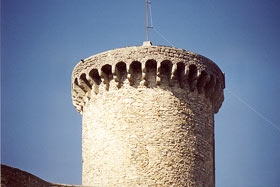 |
The castle, excellently preserved and today residence
of privates, has the aspect of a thick square fortification, with four
round towers to all the angles and a higher one inside with the function
of keep. The two towers nearest the keep have a greatest circumference
as the others. The actual aspect is clearly of a bastionated fortress
of the 15th century, but the presence of the aforesaid tower in the middle
of the enclosure lets us think that all this may be the result of the
updating of a previous small medieval fortress. After all, due to the
highly strategic position of the fortification, the contrary would be
strange.
The castle is visible only from the outside, however
we can notice the extraordinary solidity of the construction and the
remnants of the brackets that sustained the machicoulis (or machicolation,
projection from the wall made of stone which has openings through which
the defenders can fire upon an enemy directly below) along the whole
curtain wall.
The battlements don't exist anymore but, as in all the
other castles of this area, they had the form of 'tail of swallow'
also said 'Ghibelline'. Very interesting are also the loopholes and gunholes
opened in the bastionated walls, for their form suited for the use of
fire weapons, probably a 16th century's addition. The primitive gate,
unique way to access the inner courtyard and the keep that opens itself
at a certain height from the ground, has been replaced by a stone stairway,
under whose arc are still visible the remnants of its original form.
